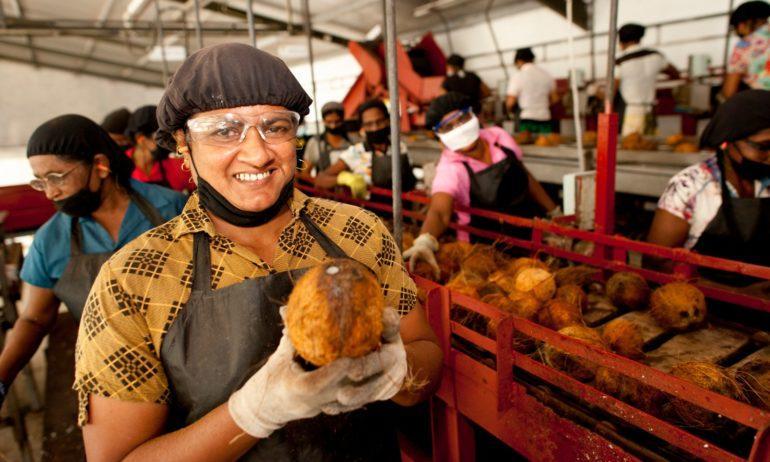
The Regenerative Organic Certified (ROC) program, a rigorous sustainability certification for foods, fibers, and personal care products, is now publicly available after a yearlong pilot phase. The first ROC-certified products are also now on sale from producers including Dr. Bronner’s, Nature’s Path, Patagonia Provisions, and more.
 This product from Lotus Foods displays a silver Regenerative Organic Certified label. Photo courtesy Regenerative Organic Alliance.
This product from Lotus Foods displays a silver Regenerative Organic Certified label. Photo courtesy Regenerative Organic Alliance.
The ROC standards, which began development in 2017, are based around three pillars: soil health and land management, animal welfare, and farmer and worker fairness. Farms and producers can be evaluated at three tiers—bronze, silver, and gold—and are required to make improvements to continually progress through the levels.
“The Regenerative Organic Alliance exists to promote regenerative organic farming as the highest standard for agriculture around the world,” Regenerative Organic Alliance (ROA) Executive Director Elizabeth Whitlow tells Food Tank. “If you’re talking about [regenerative] organic farming, you are in the living trust of the Earth. … Any holistic system encompasses the health of all the living beings in that farming community. This means animals, that the livestock are treated humanely, and that workers are treated fairly and farmers are paid a premium.”
To be eligible for ROC certification, participants must already be certified organic by the U.S. Department of Agriculture or an equivalent body in their country. ROC criteria then require additional sustainable and equitable practices beyond the scope of many national organic protocols. Requirements include crop rotation and yearlong cover, rotational grazing, livestock feed from organic or regenerative sources, and protections for workers against harassment, wage theft, and intimidation.
Bronze certification calls for 25 percent of an operation’s land to meet ROC criteria upon certification and 50 percent within five years, and silver requires 50 percent of land to be in compliance upon certification and 75 percent within five years. To qualify for gold ROC certification, 100 percent of an operation’s land—and 100 percent of their revenues—must meet all criteria immediately.
“Growing food and fiber with industrial techniques and harmful chemicals is having devastating effects on human health and the health of our planet,” Birgit Cameron, managing director of Patagonia Provisions, said in a statement. “This type of farming degrades soil, which over time reduces our ability to grow healthy crops and contributes to the loss of topsoil and water-limited resources we can’t afford to waste. Switching to regenerative organic practices builds healthy soil and draws even more carbon back into the ground, turning our agricultural system from problem to solution.”
The Regenerative Organic Alliance was founded in 2017 by companies and organizations including Patagonia, Dr. Bronner’s, and the Rodale Institute. As good as USDA organic certification is, Whitlow says, ROA founding members thought a more high-aiming, all-encompassing standard was necessary to encourage consumers to support products that truly rebuild ecosystems. During the yearlong pilot program that ended in January 2020, certifiers travelled around the world to conduct audits, some of which lasted as long as 12 days; the ROA board then made final changes to the standards before the public launch.
Whitlow says she’s “painfully aware” that all current ROA board members are white, and as the board looks to expand and fill an upcoming vacancy, she says a priority is recruitment of leaders from underrepresented backgrounds, including farmworker communities.
“Looking at women of color who farm—and especially those who are raising multi-species livestock—is one of my emphases right now,” Whitlow tells Food Tank. “Our board needs people who are very versed in farming.”
The cost structure for ROC certification is also designed to be friendly to small farmers, she says. To obtain ROC certification, participants pay a fee of approximately 0.1 percent of sales for farms and 0.2 percent of sales for brands, to cover auditing costs.
Whitlow says her next goal is to fundraise for a cost-share program to support farmers making the transition to regenerative practices. As ROC participants come into compliance with the standards, she says, they might see temporary dips in yields or extra costs to meet soil sampling requirements. Her hope is that the Regenerative Organic Alliance can help offset these costs to encourage participation.
“The global crisis we’re in right now is highlighting the need for systemic change in our farming systems and food supplies,” she tells Food Tank. “Workers in food systems are risking their health and their lives every day, and because they don’t get paid enough as is, they can’t afford not to go to work. It’s all part of the same problem and it’s all showing us the need for change and a systemic overhaul. That’s what we’re trying to accomplish.”
Header photo courtesy Dr. Bronner’s via Regenerative Organic Alliance.
